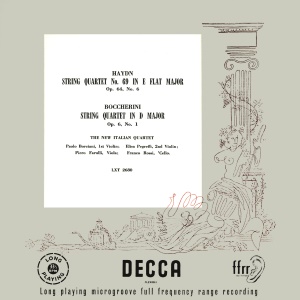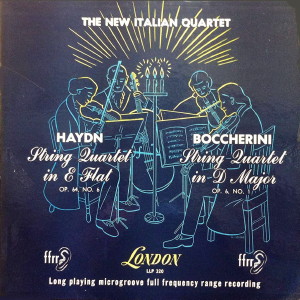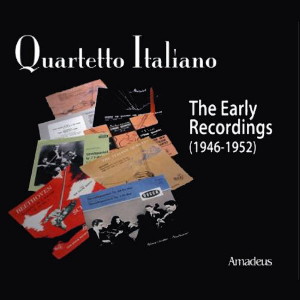 |
Decca
- 1 LP - LXT 2680 - (p) 06/1952
|
 |
| London -
1 LP - LL 320 - (p) 04/1952 |
 |
| Amadeus
- 7 CDs - AMP 007-013 - (p) 2009 |
|
| Joseph Haydn
(1732-1809) |
|
|
|
|
|
|
|
| String
Quartet in E flat major, Op. 64
No. 6 (Hob. III:64) |
|
17' 04" |
|
| -
Allegretto |
5' 01" |
|
|
| -
Andante |
4' 55" |
|
|
| -
Minuetto (Allegretto) |
3' 38" |
|
|
| -
Finale (Presto) |
3' 30" |
|
|
|
|
|
|
| Luigi Boccherini
(1743-1805) |
|
|
|
|
|
|
|
| String
Quartet in D major, Op. 8 No. 1 (G
165) |
|
13' 06" |
|
-
Allegro vivace
|
3' 56" |
|
|
| -
Adagio |
6' 02" |
|
|
| -
Minuetto in Rondo (Allegretto
grazioso) |
3' 26" |
|
|
|
|
|
|
THE NEW ITALIAN QUARTET
- Paolo Borciani, Elisa Pegreffi, violino
- Piero Farulli, viola
- Franco Rossi, violoncello |
|
|
|
|
|
Luogo
e data di registrazione |
|
West
Hampstead Studios, Londra
(Inghilterra)
- 11 novembre 1948 (Haydn)
- 11 e 20 novembre 1948
(Boccherini)
|
|
|
Registrazione:
live / studio |
|
studio |
|
|
Producer /
Engineer |
|
- |
|
|
Matrici 78rpm |
|
Decca
- AR 12935-38 (Haydn)
Decca - AR 12965-68: (Boccherini)
|
|
|
Prima Edizione
78rpm |
|
Decca
- AK 2159-60 - (12") - (p) 10/1949
(Haydn)
Decca - AK 2173-74 - (12") - (p)
06/1949 (Boccherini)
|
|
|
Prima Edizione LP |
|
Decca
- LXT 2680 - (1 LP) - (p) 06/1952
- Mono
London - LL 320 - (1 LP) - (p)
04/1952 - Mono
|
|
|
Prima Edizione CD |
|
Paragon/Amadeus
- AMP 007-013 - [7 CDs - (1°,
6-12)] - (p) 2009 - ADD
|
|
|
Note |
|
Philip
Stuart, nel suo libro "Decca
Classical, 1929-2009", riporta
l'anno di pubblicazione del disco
a 33 giri (LXT 2680) come il 1952.
L'anno 1949, riportato anche
nell'integrale Decca del 2015, fa
sicuramente riferimento alla
pubblicazione in disco a 78 rpm. |
|
|
|
|
HAYDN:
STRING QUARTET No. 6
IN E FLAT MAJOR, Op.
64, No. 6
Haydn
issued in 1790 a number
of quartets that brought
his total in that form
to nearly seventy. He
produced them in
half-dozens. These of
Op. 64, like the six
that came just before
them, were dedicated to
one Johann Tost, whi
played in the orchestra
that Haydn conducted for
his master at Ersteházy
Castle.
First
Movement: Allegretto
Here is exhibited one
of the habits which
enlarged sonate style;
instead of using two
clear-cut, different
ideas, the main body
of the exposition is
occupied with one,
there being added a
subsidiary thought or
two. The opening
harmonic subject
impresses itself thus,
and also by making
those early
full-closes in its own
key.
After its first
statement this
cadence-point is
thrust home, even as
Haydn seems about to
develop the figure;
but immediately he
boldly takes up the
challenging start
again, in a new key,
and woth a strong
side-thrust of
harmony. Again he
seems about to
develop it, but this
time turns off to a
lighter sensibility,
in tripleting above
a repeated bass
note, the dominant
of his new key. This
kind of yhing is
familiar as a
"bridge", leading
ordinarily to the
second main subject; but
here it attends
development of the
first one, with
some new
imitations and a
little
syncopation; and
so to the
resumption of the
tripleting, which
serves as codetta,
to bring on the
main body of
development.
This
begins with more
imitation,
closer than
before; at
half a bar's
distance we
have "canonic"
imitation.
Then, for a
more exciting
spell, he
bustles his
counterpoint
along with
quicker notes
(quavers).
This is calmed
down by a
rippling
accompaniment,
whereon there
lilts a
fragment of
the imitative
tune, in
various
friendly keys.
More than a
dozen times it
is used; when
suddenly there
breaks in the
original
tune-shaping,
but in the
remote key of
G flat. It is
due for a
little more
extension, and
a striking
progress to G
major, befor -
without any
modulation
from that key
- the real
recapitulation
comes, in the
original one
of E flat.
The
last section
is by no means
a simple
repetition of
the first.
Ornamental
notes enliven
it, some of
the first
part's
development is
cut out, and
we reach in a
dozen bars the
spot which
before we
arrived at
only after
twenty-seven.
But he must
have a coda,
so, having
diminished his
recapitulation,
he develops an
idea from the
first subject
(jumping
siths), and
the quaver
skips, before
winding up
with more
triplets,
after the
manner of the
exposition.
Second
Movement:
Andante
This is one of
the lucid,
smooth
Andantes of
which he had
become fond.
We have just a
page of
floating
colour, in
long lines of
ascent, like
banners of
sunset gold.
The melody is
at first
suave, and
then takes on
more freely
curved
outlines. As
its regular
eught-bar
sentences seem
to be ending,
there
dovetails in
one of those
little stormy
episodes in
which Haydn
wielded such
swift power.
He
still ascends,
but how
differently
now, in the
intensity of
minor-key
emotion,
the first
violin soaring
in concerto
style. The
accompaniment
is solid,
through soft.
The flashes
are brief;
long before a
score of bars
have been
filled the
little
turbulence
passes, and we
return to the
placid, warm
earth, in a
slightly
shortened and
still freshly
varied form of
the first
page.
Third
Movement:
Minuetto
(Allegretto)
A Pleasant,
plain
sturdiness,
informed with
the usual
little
subtleties of
build and
balance. Six
bars plus six
make the first
section of the
Minuet part.
Its middle
section is an
eicht-bar
imitative
development of
the last
phrase heard,
followed by a
repetition of
part only of
the opening;
it is actually
a sixteen-bar
extension of
that idea. Its
tiny codetta
is in
cross-rhythm,
using the
dropping
figure that is
by now
familiar.
The
Trio, in the
same key,
takes us again
(as in the
slow movement)
to the verge
of the
concerto
style, for in
its latter
portion the
first violin
accompanies on
very high
notes, some of
the loftiest
then employed
by fiddlers.
Fourth
Movement:
Finale
(Presto)
This is a
rondo, with
some happy
chromatic
scurrying in
octaves, among
the first
theme's
dance-springs.
After the
first
section's
ascents, the
second's
descents give
diversity, as
well as a bit
of development
of matter and
extension of
lenght. This
second portion
is not, as in
a rondo,
distincly
different from
the first. We
can see the
working of the
same spirit
that moved in
the First
Movement - the
tendency to
integrate
sections by
the use of
similar
material. This
gives greater
scope for
development,
in any kind of
piece.
The
little dancing
figure of four
semiquavers
(from bar 6)
is much
employed
throughout.
The effect is
of development
of established
ideas, and
there is also
much of the
general
figuration of
part one. One
figure, a
broken
arpeggio, used
by all in
octaves, will
be heard again
later.
This
leads on, with
a kind of
little
present-arms,
to the
repetition of
part of the
first theme;
but as soon as
we have
sufficiently
reminded of
that, matters
take a new
turn, in
strong
imitations of
a fugal order,
amid plenty of
athletic key
swinging. A
little fresh
rhythm,
syncopated
leads on, in
the same
approach as
before, to a
third entry of
the original
theme; agian,
it only peeps
in (with a
happy
reference to
that second
theme which
itself
developed from
the first)
before the
strings run
together in
octaves, as we
noted their
doing once
earlier, and
we are in
train for the
coda, which
makes pretence
of pulling up
for some final
crash - on, of
all humorous
basses, C flat.
There is a
moment of
Haydn's
favourite
pussyfooting,
with rests; a
reminder of
the finish of
the first
theme, and yet
another
teasing
pretence, in
slower notes;
then we get
one last wave
of the hand
from the
original theme
as it flashes
past, and is
gone.
BOCCHERINI:
STRING QUARTET
IN D MAJOR,
Op. 6, No. 1
Luigi
Boccherini
lived from
1743 to 1805 -
a period
closely
corresponding
to that of
Haydn. In
addition to
being a fine
'cellist, he
was the
composer of a
large number
of
instrumental,
choral and
orchestral
works. Very
little of his
voluminous
output has
survived,
although
certain
isolated
movements -
such as the
famous
"Minuet" -
have won wide
popularity.
The
first movement
of the D major
String Quartet
starts Allegro
vivace with an
active, rising
theme which
soon gives way
to a
contrasted
melody of a
more lyrical
nature. The
form of the
movement is
extremely
simple;
although the
first theme
undergoes some
charming
modulations at
its later
reappearance,
the movement
falls clearly
into thematic
sections which
may be
indicated by
the letters
ABAB. One of
the
subsidiaries
which follows
the second
subject (B)
forms the
basis of the
delightful
coda with
which the
movement ends.
The
heart of the
Quartet is to
be found in
the very
beatiful
second
movement,
adagio. Not
only the main
theme, but its
treatment,
indicates that
Boccherini was
a composer of
depht and
sensitivity.
The movement,
again simple
in its formal
construction,
is an extended
meditation of
a theme
introduced at
its start by
the first
violin. It is
interesting,
in view of the
later
treatment, to
notice the
undulating
accompaniment
provided by
the other
instruments. From
the gentle,
rather
melancholy
theme,
Boccherini
evolves a
movement of
great beauty;
the
accompaniment
gradually
rises in
intensity,
while the
theme - still
the property
of the violin
- weaves its
phrases in and
out of the
texture. The
outline of the
first phrase
is rarely
absent in the
series of
integrated,
continuous
variations of
which the
movement is
made up.
The
finale is
formally the
most
interesting
movement of
the work. Its
first theme -
a gentle
minuet - is
treated as a
rondo. The
movement,
though short,
is remarkably
concise
and
beautifully
balanced; its
form could be
described as
ABACBCA. A
bried coda,
based on the
minuet theme,
concludes this
delightful
quartet.
LXT 2680
(rectus)
|
|
|